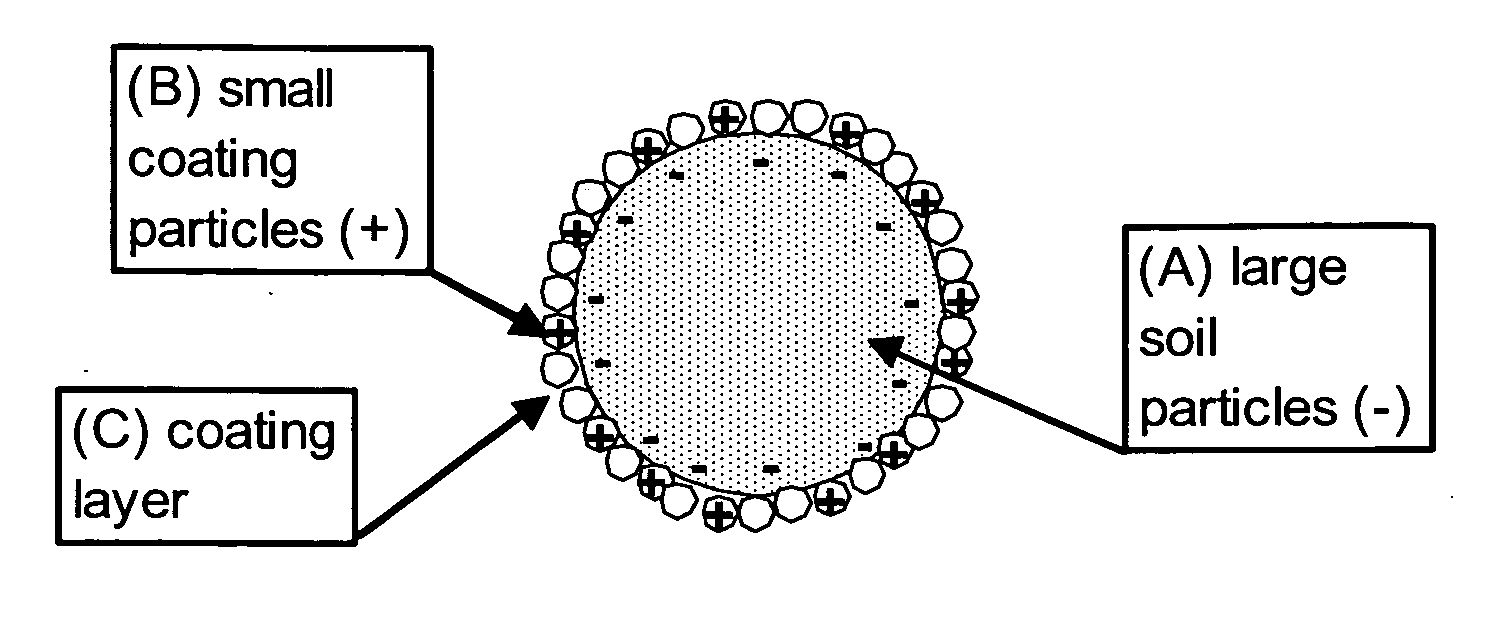Soil remediation through surface modification
a surface modification and soil technology, applied in the field of composition and a process for forming a remediated soil, can solve the problems of soil structure or texture degradation, loss of top soil, and challenge to the world crop production community
- Summary
- Abstract
- Description
- Claims
- Application Information
AI Technical Summary
Benefits of technology
Problems solved by technology
Method used
Image
Examples
example-1
[0043]A soil sample, Mississippi loess from Natchez, Miss., was in the form of big lump of 8-9 cm. Powder sample was removed from the exterior. It is more or less dry and grainy. The powder sample was mixed with distilled water using a spatula to give a mixture containing 165 mg of loess in 300 grams of water. The mixture was further homogenized by shaking in a sealed polypropylene bottle for 3 minutes. The slurry sample was used for measuring zeta potential. The slurry was not stable and settled quickly. This sample was diluted using a 1.0 mM KCl solution to give roughly 0.025 mg of solid sample per 1 ml of diluted sample for zeta potential measurement using ZetaPals from Brookhaven Instrument Co., New York. The instrument was first validated using a BI ZR3 standard provided by the instrument manufacturer. The dilute sample had initial pH of 6.4. To obtain a zeta potential curve, pH was varied by adding a diluted hydrochloric acid to bring down pH or adding a diluted potassium hydr...
example-2
Invention
[0044]A commercial charcoal, Kingsford charcoal briquettes were from made by Kingsford Product Company. The briquettes were ground to a power before mixed with distilled water. The solid concentration and mixing procedure followed that of Example-1 for making the loess sample. Zeta potential measurements were done using the same Brookhaven ZetaPals instrument according to the same procedure as that used in Example1. The zeta potential curve of the Kingsford charcoal is given in FIG. 4. It showed negative zeta potential even when pH is lowered to 2. If there is an IEP, it has to be below pH of 2. This charcoal sample is highly negatively charged at pH>3. It may become positively charged at pH<2. This behavior is similar to that of the Mississippi loess soil.
example-3
Invention
[0045]A high surface area activated carbon, Black Pearls 2000 was from Cabot Corporation, Bellerica, Mass. It has a BET surface area of 1500 m2 / g measured using a Micromeritics ASAP 2420 from Micromertics Instruments, Norcross, Ga. Using t-plot, we derived a micropore surface area of 1123 m2 / g. A slurry containing 165 mg of carbon black in 300 grams of distilled water was made according to the same preparation procedure used in Example-1. Zeta potential measurement and sample preparation are the same as that used in Example-1. The zeta potential curve of Black Pearls 2000 is given in FIG. 5. It has an IEP of 8.7. Zeta potential of Black Pearls 2000 has a much steeper change than the Mississippi loess soil and the Kingsford charcoal. It is highly negatively charged at pH>8.7, and becomes positive at pH<8.7. At neutral pH, it is highly positively charged.
PUM
| Property | Measurement | Unit |
|---|---|---|
| median particle diameter | aaaaa | aaaaa |
| median particle diameter | aaaaa | aaaaa |
| solid mass ratio | aaaaa | aaaaa |
Abstract
Description
Claims
Application Information
 Login to View More
Login to View More - R&D
- Intellectual Property
- Life Sciences
- Materials
- Tech Scout
- Unparalleled Data Quality
- Higher Quality Content
- 60% Fewer Hallucinations
Browse by: Latest US Patents, China's latest patents, Technical Efficacy Thesaurus, Application Domain, Technology Topic, Popular Technical Reports.
© 2025 PatSnap. All rights reserved.Legal|Privacy policy|Modern Slavery Act Transparency Statement|Sitemap|About US| Contact US: help@patsnap.com



